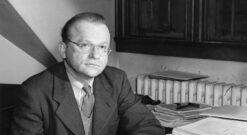According to Edward Shils, the elite creators and patrons of the term “mass society“ stressed alienation, atomization, and moral emptiness.
Old Mistakes From the New Right
The American right is engaged in a complicated and increasingly dirty conflict. On one side is the new right, committed to political populism, the hostile takeover of the state, and more communitarian economic policies. Opposing them is the old right, a hodge-podge collection of individuals committed to limited government, free markets, and a bellicose foreign policy. The right is locked in the often fractious process of trying to reforge a functional coalition. There’s some space for discussion and negotiation; after all, it’s not as if political coalitions are ever moving completely in lockstep, with perfectly aligned principles. But some things are a bridge too far. Sometimes you must acknowledge that even a big tent cannot cover absolutely everyone. Many of the new right’s ideas can lead down the path to political and intellectual bankruptcy.
Nowhere is this more evident than in a recent essay published by Nick Solheim for The American Mind. In the essay, Solheim tries to outline an intellectual foundation for the new right. This is a laudable task for any political movement, and I must congratulate him for his attempt at thoughtfulness. In the final analysis though, his essay was rambling and philosophically confused. Despite the murkiness of his argumentation, Solheim’s argument does have one discernable theme: a desire to end the pluralist foundations of the American regime. This task blatantly sheds the conservative exterior of the new right and reveals the most tyrannical chamber of its heart.
Solheim’s fascinating articulation of America’s problems is of course not all wrong. First, he is absolutely right to point out that our current moment is one plagued by serious political problems. Corrupt business leaders and a dangerously unaware media seem intent on uprooting the very foundations of American society. However, Solheim misses the extent to which populist rhetoric, as used in his own essay, further exacerbates the problem. Instead of alerting the upper class of American society to their own frailties, the rhetoric of the elites vs. the people instantly puts them on the defensive. In short, Solheim forgets that few people under assault feel open to changing their views, and if anything, are inclined to double down on their mistakes.
Second, Solheim is right to point out that the administrative state is here to stay. We may not have to like this fact, but no nation on earth can function without some form of administrative state. Solheim is also right to point out that the permanence of the state does not imply it cannot be reformed. However, in outlining the reforms he would like to see, Solheim loses the plot a bit. He advocates for agencies to be restaffed with individuals who “truly represent the people they serve.” Setting this demand in the context of the rest of the essay, it’s hard to believe that Solheim actually wants bureaucrats attuned to the real views of the American people. Setting that to the side, however, one cannot help but be baffled by how widely Solheim misses the real problem with the current American state.
It should be made clear that the vast majority of the state’s work is entirely harmless, helpful even—ensuring our meat is safe to eat, securing our nuclear weapons, and so on. The problem is the various small parts that are not harmless—the parts of the state that seek to invade each and every facet of our lives and tell people how to live. It is precisely this portion of the state that presumably the new right wishes to take over since it is hard to imagine that Solheim wishes to accomplish his political aims by setting standards for milk pasteurization or checking road gradations. In this respect, Solheim does not so much want to solve the problems posed by the modern American state, as exacerbate them. He accurately states that education in the United States has become frequently trapped in an unhealthy progressive dogmatism. However, this is the product not of some inevitable liberal drift but instead of the creation of a thuggishly interventionist regulatory state. Solheim seems to see a forced conservative curriculum in schools as the only real alternative to overweening progressivism. Likewise, the essay heavily implies that there is some appropriate role for the state in perpetuating traditional gender norms. As I have pointed out elsewhere, these types of statist attempts to create a virtuous society are doomed to fail since they fundamentally misunderstand the nature of virtue.
The religious wars of the early modern period or the cruel despotism of modern Iran should give us some idea of what life becomes when the state adopts an official answer to all important questions.
Third, Solheim is entirely correct to point out that “societies are not built on individuals but on households, congregations, towns, and counties.” These are indeed the foundations of any happy society and the bastions of freedom in our modern world. If only Solheim did not clearly support the exact mindset that is leading to their untimely demise. Immediately after defending local institutions as the home of true civilization, he states that what America really needs is “a hero”—someone whose legitimacy stems not from votes but the “unyielding pursuit of a common cause” that “rewards friends and punishes enemies.” Such authoritarian leaders are not particularly famous for respecting local sovereignty. If Solheim really wished to promote subsidiarity, he would call for leaders who surrender authority rather than seize it. For these little platoons are sustained not by foisting upon society a particular conception of the common good, as Solheim would clearly like to do, but by surrendering such questions to them. A new right sophist forcing his views upon a small progressive parish in Massachusetts is no different from a progressive activist in California forcing his views upon a conservative church in Alabama. Both undermine the power of intermediary institutions. Of course, it is possible that Solheim simply sees the local communities he so cherishes as the best path to enforcing his social views throughout the entire country. This, at least, would make his political position coherent, even if more terrifying.
Here though we come to the ultimate truth that underlies every misstep and logical fallacy Solheim makes—his political philosophy is driven by a deep-seated contempt for pluralism. He cannot stomach the idea of a nation where people do not provide a uniform answer to the most important moral questions. He is unwilling to consider that a society can function without firmly agreeing upon gender, religion, or the purpose of human life. His alternative vision for America is one that settles all difficult moral disputes by putting the right people into power, once again making America a “culturally homogenous nation.”
Setting aside the obvious fact that the United States has always been one of the most culturally diverse nations in modern history there is no reason to believe his vision would create a thriving or virtuous nation. One need not even disagree with his many moral pronouncements to realize this, because a society that is founded upon one firm systematic moral view is doomed to perpetual conflict—both through the rebellion of dissenting citizens and disagreeable foreign powers. The religious wars of the early modern period or the cruel despotism of modern Iran should give us some idea of what life becomes when the state adopts an official answer to all important questions.
The irony of all of this is that, to the extent America has a single moral mission, pluralism is it. The American framers of our constitution understood, far better than Solheim does, that the age of cultural homogeneity was fast passing. The only alternative was to create a social framework in which people who differ in many important respects can learn to live together in harmony. It is for this reason that our Constitution works the way it does, providing space for local communities to define goodness for themselves while also offering rules that prevent mistreatment.
It is perhaps unfair to associate the new right with each and every one of Solheim’s arguments. After all, one man can hardly be seen to represent an entire school of thought. Nevertheless, his essay gives voice to many concerning trends among national conservatives: an unwillingness to work towards pragmatic compromise, the imposition of a firm vision of the common good through the apparatus of the state, and the promotion of petty strong men who will inevitably steamroll local democracy. Political thinkers and activists of all stripes must stand against these trends if they wish to truly restore the American republic. Solheim’s essay also serves as an important lesson to those who wish to promote the ideas of the new right. Like it or not, the country is not prepared to give way to nationalist tendencies. To promote some of their goals, national conservatives will need to join forces with localist liberals and establishment conservatives. Attacking pluralism and praising political inflexibility are exactly the wrong ways to go about doing this.
Solheim concludes his essay on a positive note, arguing that in all “endeavors, our general goal is not to retreat to some romanticized past but to steer our nation towards a future that respects our historical roots, upholds our cherished way of life, and promotes the common good.” Such sentiments should be the aim of all political movements, and it is at least heartening to know that Solheim knows the standards all political ideals should be held to. Even if he fails to meet each and every one of them.



